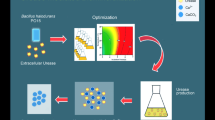Abstract
Amidases are ubiquitous enzymes that have received increased attention due to their wide range of biotechnological applications, especially in industries for the synthesis of wide variety of carboxylic and hydroxamic acids, which find applications in pharmaceuticals, agrochemicals and waste water treatments. In the present study, 40 bacterial isolates were screened for extracellular amidase-producing capability, and on the basis of color development, 5 isolates were selected for amidase production in broth media. Based on enzyme production, one of the most potent isolates identified as Pseudomonas putida AP-2 was selected for further study. The effects of media composition and various fermentation conditions for optimization of amidase production were studied. The maximum extracellular amidase production was obtained at 30 °C and pH 8.0 after 36 h of incubation in shaking condition. Among the substrate, acetamide was the best; however, P. putida AP-2 also utilized acrylamide which is a known carcinogen. Regarding carbon sources, glucose was the best, while peptone was found the best nitrogen source. The isolated bacterium, P. putida AP-2, is also tolerant to number of heavy metals at higher levels so this may also be applied for field application in contaminated soil.








Similar content being viewed by others
References
Baek DH, Song JJ, Lee SG, Kwon SJ, Asano Y, Sung MH (2003) New thermostable d-methionine amidase from Brevibacillus borstelensis BCS-1 and its application for d-phenylalanine production. Enz Microb Technol 32:131–139
Banerjee A, Sharma R, Banerjee UC (2002) The nitrile degrading enzymes: current status and future prospects. Appl Microbiol Biotechnol 60:33–44
Bauer AW, Kirby WMM, Sherries JC, Turck M (1966) Antibiotic susceptibility testing by a standardized single disc method. Am J Clin Pathol 45:493–496
Bhalla TC, Kumar J, Kumar H, Agrawal HO (1997) Amidase production by Rhodococcus sp. NHB-2. NAS Lett 20:139–142
Bradbury AF, Smyth DG (1991) Peptide amidation. Trends Biochem Sci 16:112–115
Burd GI, Dixon DG, Glick G (1998) Plant growth promoting bacteria that decrease heavy metal toxicity in plants. Appl Environ Microbiol 64:3663–3669
Caro LG, Churchward G, Chandler M (1984) Study of plasmid replication in vivo. Meth Microbiol 17:97–122
Cervantes C, Chavez J, Cardova NA, de la Mora P, Velasco JA (1986) Resistance to metal by Pseudomonas aeruginosa clinical isolates. Microbios 48:159–163
Chacko S, Ramteke PW, John SA (2009) Amidase from plant growth promoting rhizobacterium. J Bacteriol Res 1(4):046–050
Chacko S, Ramteke PW, Joseph B (2012) A comparative study on the production of amidase using immobilized and dehydrated immobilized cells of Pseudomonas putida MTCC 6809. J Gen Eng Biotechnol 10:121–127
Ciskanik LM, Wilczek JM, Fallon RD (1995) Purification and characterization of an enantioselective amidase from Pseudomonas chlororaphis B23. Appl Environ Microbiol 61:998–1003
Egorova K, Trauthwein H, Verseck S, Antranikian G (2004) Purification and properties of an enantioselective and thermoactive amidase from the thermophilic actinomycetes Pseudonocardia thermophila. Appl Microbiol Biotechnol 65:38–45
Ellens KW, Richardson LGL, Frelin O, Collins J, Riberio C, Hsieh Y-F, Mullen RT, Hanson AD (2014) Evidence that glutamine transaminase and omega-amidase potentially act in tandem to close the methionine salvage cycle in bacteria and plants. Phytochem. doi:10.1016/j.phytochem.2014.04.012
Holt JG, Krieg NR (1984) Bergey’s Manual of systematic bacteriology. Williams, Wilkins, editors. Baltimore: Springer; 1st ed (vol 1–4), p 1105–1139
Imada A, Igarsasi S, Nakahoma K, Isono M (1973) Asparaginase and glutaminase activities of microorganisms. J Gen Microbiol 76:85–99
Makhongela HS, Glowacka AE, Agarkar VB, Sewell T, Weber B, Cameron RA, Cowan DA, Burton SG (2007) A novel thermostable nitrilase superfamily amidase from Geobacillus pallidus showing acyl transfer activity. Appl Microbiol Biotechnol 75:801–811
Nampoothiri MK, Roopesh K, Chacko S, Pandey A (2005) Comparative study of amidase production by free and immobilized Escherichia coli cells. Appl Biochem Biotechnol 120:97–108
Nawaz MS, Chapatwala KD (1991) Simultaneous degradation of acetonitrile and biphenyl by Pseudomonas aeruginosa. Cand J Microbiol 37(6):411–418
Nochure SV, Roberts MF, Demain AI (1993) True celluloases production by Clostridium thermocellum grown on different carbon sources. Biotech Lett 15:641–646
Pal A, Samanta TB (1999) β-lactamase-free penicillin amidase from Alcaligenes sp.: isolation strategy, strain characteristics, and enzyme immobilization. Curr Microbiol 39:244–248
Prasad S, Sharma DR, Bhalla TC (2005) Nitrile- and amide- hydrolysing activity in Kluyveromyces thermotolerans MGBY 37. World J Microbiol Biotechnol 21:1447–1450
Rahim MA, Saxena RK, Gupta R, Sheoran A, Giri B (2003) A novel quick plate assay for acetamidase producers and optimization for its production by Aspergillus candidus. Process Biochem 38:861–866
Ruzzante DE, Taggart CT, Cook D (1996) Spatial and temporal variation in the genetic composition of a larval cod (Gadus morhua) aggregation: cohort contribution and genetic stability. Canad J Fish Aquat Sci 53:2695–2705
Sharma M, Sharma N, Bhalla TC (2009) Amidases: versatile enzymes in nature. Rev Env Sci Biotech 8:343–366
Timoney JF, Port J, Gills J, Spanier J (1978) Heavy-metal and antibiotic resistance in the bacterial flora of sediments of New York Bight. Appl Environ Microbiol 36:465–472
Trevors JT (1986) Plasmid curing in bacteria. FEMS Microbiol Rev 32:149–158
Wang YS, Xu JM, Zheng RC, Zheng YG, Shen YC (2008) Improvement of amidase production by a newly isolated Delftia tsuruhatensis ZJB-05174 through optimization of culture medium. J microbial Biotechnol 18:1932–1937
Author information
Authors and Affiliations
Corresponding author
Rights and permissions
About this article
Cite this article
Abada, E.A. Production optimization of extracellular amidase enzyme by newly isolated Pseudomonas putida AP-2 from agricultural soil. Rend. Fis. Acc. Lincei 25, 523–530 (2014). https://doi.org/10.1007/s12210-014-0347-4
Received:
Accepted:
Published:
Issue Date:
DOI: https://doi.org/10.1007/s12210-014-0347-4




